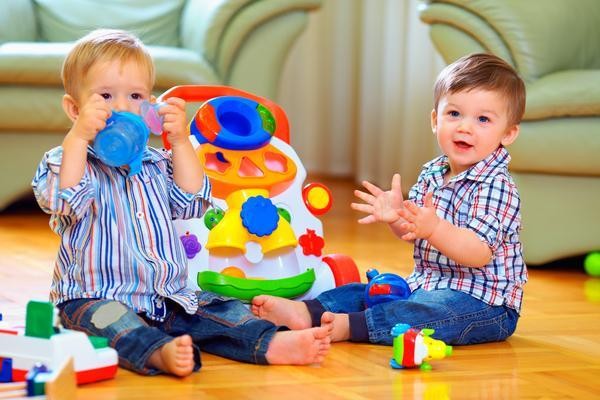What smells?
For children 3 years.
In advance, you should prepare items with a specific smell - soap, shoe cream, garlic, lemon, etc. Children should consider all items in advance, tell which of them are edible, smell together and try to determine the smell - sour, bitter, sweet, pleasant or unpleasant, edible or inedible.
Then, tie the child's eyes and offer a smell to determine each object.
The game develops memory, imagination, and speech.
Sinks - does not sink
Spread an oilcloth, in the middle, put a basin of water. Around disintegrate various small sinking and non-sinking objects. Let the child begin to throw various things into the water (pieces of cloth, cardboard, coins, etc.) and see how they behave in the water. All his actions comment. After that, let the child get the objects out of the water. You again comment on his actions (the cardboard is wet and torn, and the coins are the same solid, etc.).
Hide the bunny from the fox
Draw in the center of the sheet with a pencil or a felt pen. Show the baby.
Tell your child a short tale:
"There was a bunny. He was very fond of carrots. But in order to get to the carrot, you had to run past the fox every time. The bunny was very afraid of the fox. And the fox was just waiting for the bunny to go for the carrot. Here our rabbit has gathered for a carrot, and the fox has hidden and waits. Bunny quietly sneaks, but the fox cannot be fooled! Oh, now he's catching the fox bunny! Where should our rabbit go? Let's help the bunny, hide it. "
Then give the kid a pencil or a felt-tip pen of the same color as the bunny, suggest painting the entire bunny (shading). But first, show how it's done. When the bunny is completely shaded, praise the baby for saving him from the fox.
Fold the tape
For children 2,5-3 years.
Arrange for your kid an interesting competition to fold multicolored ribbons glued to the rods (which are easy to make, for example, from pencils). If the tapes are of different lengths, folding the long tape will take longer.
Pay attention to the child that one of the tapes can be rolled faster than the other. Unfold the ribbons to their full length and place them side by side so that the difference in length is clearly visible.
Ball on the hill
A game for the development of thinking.
Make a small slide. This can be any board, placed at an angle to the plane of the table. At some distance from the hill, draw a line. Give the child a small ball and ask him to lower the ball from the slide so that it stops near the dash. At first, the kid will be mistaken, but after a while, he will learn to accurately find the ratio of the location of the ball on the hill and the range of its range.
Guess who's been asked!
In the game, along with the baby can participate in his favorite toys, such as a doll, gnome, and bunny. It is important that they are large enough, and they can be planted or placed in front of the child, behind him and on the side of him.
Place or put the child in the center, and place the toys around. Tell me that one of them was made, and he needs to guess which one. The coordinates of the toy, for example, are the following: it sits sideways from you (or in front of you, behind you). The kid should name the toy, located in the specified place. Then swap places, seat the toys around you. Now guessing the coordinates of the toy will be a child.
Comparison
The game teaches the child to relate objects with different characteristics.
Invite the baby to look at 2 puppies and say how they differ. The child should give the puppets names (Lena and Ira) and tell them that Lena has light and short hair, Ira has dark and long hair, Lena has gray eyes, Ira has black hair, Lena is wearing a dress, and Ira is wearing a skirt, then the dolls have different clothes.
Then start asking the child the questions that he needs to answer. "The dolls wanted to play, they took ... (balls). This ball ... (round, rubber, blue, small), and the other ball ... (big, red). What can you do with the balls ... (throw, catch, throw). Look at this ball. It is larger than blue, but smaller than red. What kind is he? (Average.)"
Tell me what
The game develops thinking, speaking and teaches us to distinguish and name the attributes of the object.
You will need a box and various items. Then remove the object from the box and name it: "This is an apple," and ask the child to name the signs: "It's red, tasty." "This is a tomato." - "He is red, round, ripe, juicy", etc.
Once upon a time, there were…
A game for the development of thinking, ingenuity, consolidation of knowledge about the world around us. You can play together with a child or a company, asking questions in turn.
For children of 1 year, the questions should be simple, for older ones it is more difficult.
The adult asks the question:
"Once upon a time, there was a chicken, what happened to him then?" - "He became a cockerel."
"Once upon a time, there was a cloud, what became of it then?" - "From it, the rain spilled."
"There was a stream, what became of him?" - "In the winter it froze (it withered in the heat)".
"There was a seed-there was a seed, what became of him?" - "The flower grew out of it."
"There was a piece of clay, what happened to him then?" - "A brick (a vase) was made from it," etc.

